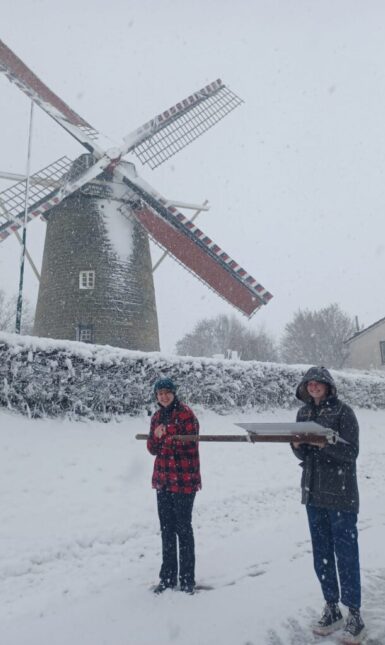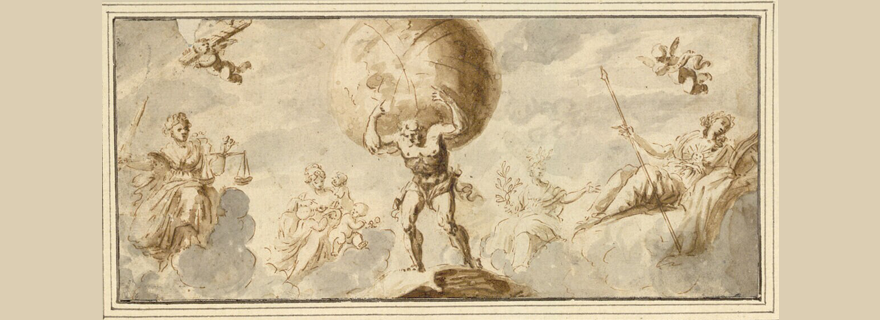Studying the Sensible Side of Love in the Netherlands
During last year’s Fieldwork NL course, second-year students conducted ethnographic research on maintenance. Inspired by U.A. Fanthorpe’s poem ‘Atlas’, they explored deathcare workers, millers, and au pairs. Here they reflect on their experiences and the intricate efforts involved in sustaining “structures of living.”
This post was initially published by The Maintainers.
Last fall, we started working together to hone our fieldwork skills in self-directed ethnographic research projects on maintenance. Taking inspiration from U.A. Fanthorpe’s poem “Atlas,” which defines maintenance as “the sensible side of love,” we started from a broad understanding of maintenance and the kinds of social activities and roles it may involve. The message that initially went out to prospective student-researchers suggested we take on research centered on the following groups or activities: “those who keep our buildings clean, our roads fixed, and our trains running; those who fix bugs in our software; the services and substances that help broad swathes of the population cope with the state of the world (think of the TV show High Maintenance); as well as those who feed databases, fill in paperwork, and engage in the numerous other crucial tasks that keep our increasingly complex societies from breaking down entirely.”
Even with this background, it may be surprising how far afield our research topics ultimately took us. Working in three groups with between three and four student-researchers each, we began studying deathcare workers, millers, and au pairs, all of whom we see involved in some form of maintenance. The Maintainers’ emphasis on how maintenance tends to go underappreciated informed our choices to work in these fields. Deathcare workers tend to be invisible due to their association with mortality; millers are present as historical stereotypes but not as representatives of an ongoing craft; while au pairs, like many domestic workers, lack public representation, and furthermore are expected to return to their home countries after a year-long stay.
Now that we have completed our fieldwork among these three very different groups, we want to reflect on what we have learned about maintenance in contemporary society, especially in The Netherlands, where our work was based. Each of our projects bore the hallmark of successful ethnographic research, in that our experiences in the field surprised us and forced us to reconsider some of the assumptions we made going into the research.
Deathcare work as stigmatized maintenance?
Funeral directors are stoic, creepy, and probably just out to relieve you of your money when you’re at your most vulnerable. These, anyway, were some of the preconceptions we expected to encounter. The sociological literature on death, dying and end-of-life care that we read in preparation for our fieldwork primed us to expect stigmatization of death workers. We did find that, in their interactions with the public, deathcare workers often don a “mask of professionalism” and frequently encounter negative perceptions about their motivations. However, those perceptions tend to be limited to those who have had little to no contact with deathcare workers. The overwhelming majority view them with great admiration and respect, using words like “supportive,” “caring,” “brave,” and “hardworking” to characterize them and their work. A deathcare worker we spent a great deal of time with during our research described her work as “beautiful and intense,” going on to say: “I find it special to be there for people in their most vulnerable days. It is my motivation to organise the funeral perfectly so that they can say goodbye to their loved one in a good, appropriate way. It is very satisfying when that succeeds.” While some reported that friends initially discouraged them from taking up this line of work, these misgivings generally disappeared when their friends saw how meaningful the deathcare work became for them. A florist we spoke to described their work preparing funerals as “the most important thing we do, more important than a wedding or a birthday.” Throughout our fieldwork, we were kindly welcomed into the world of deathcare workers. Our own initial perceptions of the deathcare industry changed as a result, and we reflect on this time with profound appreciation for the daily work done by these crucial maintenance workers.
Run-of-the-mill maintenance?
Windmills are a fixture of the Dutch landscape, heritage sites where traditions and structures are preserved, but otherwise nothing much new happens. That, anyway, is what people may think if they’ve only ever set foot in a mill on National Mill Day. Through daily work in an active mill in the southern province of Limburg over the course of three weeks, we got to know another side of mills and the work that goes on there. The head miller, Koen, and our own immersion in the social world of the mill made us aware of surprisingly contentious debates taking place behind the picturesque facades. The main fault-line revolves around whether mills should be seen as museums or as machines. Working mills are both at once, because producing flour alone is not enough to keep the sails turning. The safety demands that come with involving volunteers, who are often older retirees, and of complying with insurance requirements result in a dynamic situation. Traditionally, safety was learned on the job. As a trainee put it, likening work in the mill to handling dangerous animals: “the more you work with it, the better you understand what the dangers are and how to avoid them.” Millers must now offer theory-heavy trainings to impart a craft that is heavy on tacit knowledge, and they constantly have to adapt routines within the mill to suit changing priorities. This stands in strong contrast to the “country competence” acquired by full-time millers from an early age. However, millers are consummate bricoleurs, and they manage to make do in the dynamic situation they find themselves in—even if they at times resent those who would turn their machines into museums.

Maintenance in exchange for what?
Au pairs take part in a year-long cultural exchange, becoming part of host families in exchange for helping out with household maintenance tasks. That, anyway, is how it works on paper. The reality is far more messy, as our research revealed quite early on. In our very first week of research, an au pair emailed us: “I hope there is something you can do about this so we can save future au pairs that might [be] misuse[d by] their future host family.” This au pair’s experience of feeling misused was not exceptional; we repeatedly found that a great deal of invisible work happens in the context of au pairing. This is enabled by racialized stereotypes about young women from the global south “just grateful to be here,” gendered expectations around carework as an expression of an innately caring and compassionate nature rather than difficult and skilled work, and the impression that the au pair system is primarily about “getting acquainted with Dutch culture and society,” as the IND, the Dutch national immigration service, puts it. One au pair told us: “It’s a job when the kids are difficult, cultural exchange when it is going well.” But even outside the trials of childcare, some au pairs felt they were powerless to refuse repeated requests to work overtime. The system does little to protect the rights of au pairs, and even the au pair agencies, who are supposed to defend their interests, will often side with host families in case of disputes. One au pair anonymously gave us this piece of advice: “Don’t become an au pair unless you can fight for your rights.” While there are of course many au pairs who have a good experience, we cannot deny the kernel of truth in this counsel. The system puts too much faith in well-intentioned host families, and does too little to redress the injustices that occur in the name of cultural exchange.
We maintain
After a year of thinking, talking about and doing maintenance, what do we take with us? Do we have a newfound appreciation for that “which upholds / The permanently ricketty elaborate / Structures of living,” to quote Fanthrope again? We embarked on research about maintenance expecting it to be an empirically rich and ethically and politically important subject matter, and in that respect our expectations proved correct. In many other ways, however, our projects surprised us. In all three cases, we gained appreciation for how elaborate these “structures of living” are, and how much work and care is expended to keep them intact.
About the authors
Rachel Cruickshank, Annika Krüger, Tomás Lind Stam, Benjamin Maldonado Fernández, Pepijn Oudes, Frances Roberts, Hanna Schoneveld, Des van Binnebeke, Eva van der Kooij, Lila van Grieken, and Holly Zijderveld are students in the Cultural Anthropology and Development Sociology (CADS) program at Leiden University. Reflecting the diverse composition of their program, they hail from six different countries across four continents, approaching their field sites in the Netherlands with varying degrees of insider and outsider status. John D. Boy was their instructor for the 2022-23 iteration of Fieldwork NL.
This blog post was originally posted on the Maintainers on 23 October 2023. The Maintainers is a global research network interested in the concepts of maintenance, infrastructure, repair, and the myriad forms of labor and expertise that sustain our human-built world. Our members come from a variety of backgrounds, including engineers, business leaders, academic historians, social scientists, government, non-profit agencies, artists, activists, coders, and more.



0 Comments
Add a comment